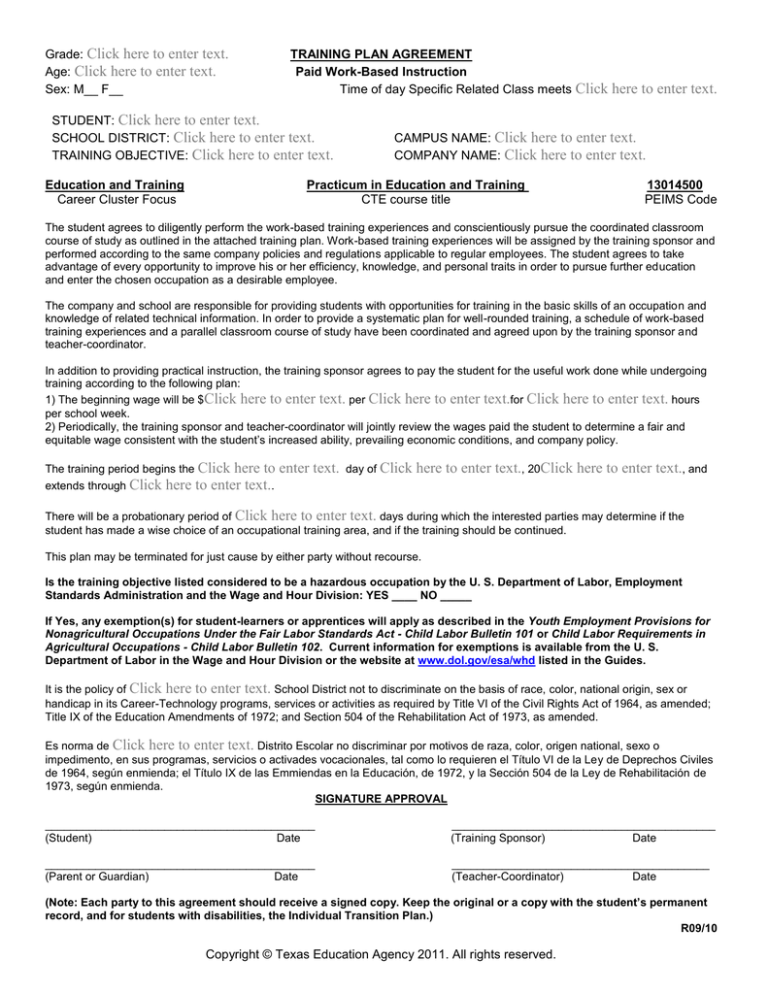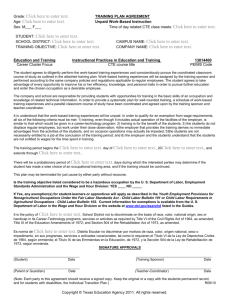
Grade: Click here to enter text.
Age: Click here to enter text.
Sex: M__ F__
TRAINING PLAN AGREEMENT
Paid Work-Based Instruction
Time of day Specific Related Class meets
STUDENT: Click here to enter text.
SCHOOL DISTRICT: Click here to enter text.
TRAINING OBJECTIVE: Click here to enter text.
Education and Training
Career Cluster Focus
Click here to enter text.
CAMPUS NAME: Click here to enter text.
COMPANY NAME: Click here to enter text.
Practicum in Education and Training
CTE course title
13014500
PEIMS Code
The student agrees to diligently perform the work-based training experiences and conscientiously pursue the coordinated classroom
course of study as outlined in the attached training plan. Work-based training experiences will be assigned by the training sponsor and
performed according to the same company policies and regulations applicable to regular employees. The student agrees to take
advantage of every opportunity to improve his or her efficiency, knowledge, and personal traits in order to pursue further education
and enter the chosen occupation as a desirable employee.
The company and school are responsible for providing students with opportunities for training in the basic skills of an occupation and
knowledge of related technical information. In order to provide a systematic plan for well-rounded training, a schedule of work-based
training experiences and a parallel classroom course of study have been coordinated and agreed upon by the training sponsor and
teacher-coordinator.
In addition to providing practical instruction, the training sponsor agrees to pay the student for the useful work done while undergoing
training according to the following plan:
1) The beginning wage will be $Click here to enter text. per Click here to enter text.for Click here to enter text. hours
per school week.
2) Periodically, the training sponsor and teacher-coordinator will jointly review the wages paid the student to determine a fair and
equitable wage consistent with the student’s increased ability, prevailing economic conditions, and company policy.
The training period begins the Click
extends through Click
here to enter text.
here to enter text..
day of Click
here to enter text., 20Click here to enter text., and
There will be a probationary period of Click here to enter text. days during which the interested parties may determine if the
student has made a wise choice of an occupational training area, and if the training should be continued.
This plan may be terminated for just cause by either party without recourse.
Is the training objective listed considered to be a hazardous occupation by the U. S. Department of Labor, Employment
Standards Administration and the Wage and Hour Division: YES ____ NO _____
If Yes, any exemption(s) for student-learners or apprentices will apply as described in the Youth Employment Provisions for
Nonagricultural Occupations Under the Fair Labor Standards Act - Child Labor Bulletin 101 or Child Labor Requirements in
Agricultural Occupations - Child Labor Bulletin 102. Current information for exemptions is available from the U. S.
Department of Labor in the Wage and Hour Division or the website at www.dol.gov/esa/whd listed in the Guides.
It is the policy of Click here to enter text. School District not to discriminate on the basis of race, color, national origin, sex or
handicap in its Career-Technology programs, services or activities as required by Title VI of the Civil Rights Act of 1964, as amended;
Title IX of the Education Amendments of 1972; and Section 504 of the Rehabilitation Act of 1973, as amended.
Es norma de Click here to enter text. Distrito Escolar no discriminar por motivos de raza, color, origen national, sexo o
impedimento, en sus programas, servicios o activades vocacionales, tal como lo requieren el Título VI de la Ley de Deprechos Civiles
de 1964, según enmienda; el Título IX de las Emmiendas en la Educación, de 1972, y la Sección 504 de la Ley de Rehabilitación de
1973, según enmienda.
SIGNATURE APPROVAL
___________________________________________
(Student)
Date
__________________________________________
(Training Sponsor)
Date
___________________________________________
(Parent or Guardian)
Date
_________________________________________
(Teacher-Coordinator)
Date
(Note: Each party to this agreement should receive a signed copy. Keep the original or a copy with the student’s permanent
record, and for students with disabilities, the Individual Transition Plan.)
R09/10
Copyright © Texas Education Agency 2011. All rights reserved.
Description of Specific and Related Occupational Training
The occupational essential knowledge and skills listed below are provided as a convenience to promote quality standards in work-based training.
Additional space is available to add specific training opportunities not otherwise identified as essential knowledge and skills. NOTE: Occupational
training objectives having no state adopted essential knowledge and skills will require the training plans to be individually developed.
Essential Knowledge and Skills
for Training Objective
WorkBased
Instruction
(1) The student explores the teaching and training profession. The student is
expected to:
(A) assess personal characteristics needed to work in the teaching and training
profession
(B) compare schools based on qualities of effectiveness
(C) formulate a personal philosophy of education
(D) create a personal career plan in preparation for a career in the field of
education or training
(2) The student understands the learner and learning process. The student is
expected to:
(A) apply principles and theories of human development appropriate to specific
teaching or training situations
(B) apply principles and theories about the learning process to specific teaching or
training situations
(C) analyze personal behaviors and skills that facilitate the learning process
(D) suggest effective instructional practices to accommodate learning differences,
learner exceptionality, and special-needs conditions
(3) The student communicates effectively. The student is expected to:
(A) assess the effectiveness of personal verbal, non-verbal, written, and electronic
communication skills
(B) communicate effectively in situations with educators and parents or guardians
(C) evaluate the role of classroom communications in promoting student literacy
and learning
(D) integrate effective communication skills in teaching or training
(4) The student plans and uses effective instruction. The student is expected to:
(A) apply principles and theories that impact instructional planning
(B) develop instructional materials that align with the Texas Essential Knowledge
and Skills (TEKS)
(C) assess personal planning to meet instructional goals
(D) analyze concepts for developing effective instructional strategies
(E) analyze instructional strategies for effectiveness
(F) explain how learner feedback has been used to guide selection and
adjustment of instructional strategies
(5) The student creates and maintains an effective learning environment. The student
is expected to:
(A) create and maintain safe and effective learning environments
(B) integrate teacher or trainer characteristics that promote an effective learning
environment
(C) apply classroom management techniques that promote an effective learning
environment
(D) demonstrate specific conflict management and mediation techniques
supportive of an effective learning environment
(6) The student assesses instruction and learning. The student is expected to:
(A) develop and apply assessments to foster student learning
(B) use assessment strategies to promote personal growth and teaching or
training improvement
(7) The student understands the relationship between school and society. The
student is expected to:
(A) support learning through advocacy
(B) select school and community resources for professional growth
(C) design activities to build support of family members, community members,
and business and industry to promote learning
(8) The student develops technology skills. The student is expected to:
(A) recommend technology applications appropriate for specific subject matter
and student needs
Copyright © Texas Education Agency 2011. All rights reserved.
Individualized
Class Study
Specific Related
Study
Assignments
Essential Knowledge and Skills
for Training Objective
WorkBased
Instruction
Individualized
Class Study
Specific Related
Study
Assignments
(B) integrate the skillful use of technology as a tool for instruction, evaluation, and
management
(9) The student continues development as a teaching or training professional. The
student is expected to:
(A) identify strategies and resources for the professional development of
educators or trainers
(B) demonstrate teacher or trainer characteristics that promote ongoing
professional development
(C) use research and assessment to improve teaching or training
(D) develop a professional growth plan
(10) The student participates in field-based experiences in education or training. The
student is expected to:
(A) apply instructional strategies and concepts within a local educational or
training facility
(B) document, assess, and reflect on instructional experiences
(11) The student documents technical knowledge and skills. The student is expected
to:
(A) update a professional portfolio to include:
(i) attainment of technical skill competencies;
(ii) licensures or certifications;
(iii) recognitions, awards, and scholarships;
(iv) extended learning experiences such as community service and active
participation in career and technical student organizations and professional
organizations;
(v) abstract of key points of the practicum;
(vi) resumé;
(vii) samples of work; and
(viii) evaluation from the practicum supervisor
(B) present the portfolio to all interested stakeholders such as in a slide or poster
presentation
Advanced Occupationally Specific
Knowledge and Skills
Work-Based
Instruction
Individualized
Class Study
Specific Related
Study Assignments
NOTE: The above should serve as a suggested format. Space allowances should be expanded to accommodate inclusion of appropriate information.
R09/10
Copyright © Texas Education Agency 2011. All rights reserved.








